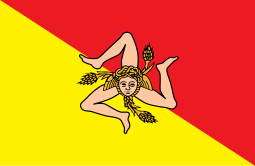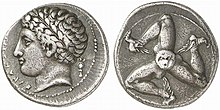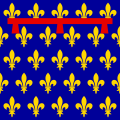Flag of Sicily
This article needs additional citations for verification. (June 2013) |
 | |
| Name | Trinacria[citation needed] |
|---|---|
| Use | Civil and state flag |
| Proportion | 2:3 |
| Adopted | 4 January 2000 |
| Design | Divided diagonally from the upper hoist-side corner; the upper triangle is red and the lower triangle is yellow; in the centre is the Sicilian triskelion featuring the head of Medusa. |
The flag of Sicily (Sicilian: Bannera dâ Sicilia; Italian: Bandiera della Sicilia) shows a triskeles symbol (a figure of three legs arranged in rotational symmetry), and at its centre a Gorgoneion (depiction of the head of Medusa) and a pair of wings and three wheat ears.
Description[]
The flag is characterized by the presence of the triskeles in its middle, the (winged) head of Medusa and three wheat ears, representing the extreme fertility of the land of Sicily,[1] The triskelion symbol is said to represent the three capes (headlands or promontories of the island of Sicily, namely: Pelorus (Peloro, Tip of Faro, Messina: North-East); Pachynus (Passero, Syracuse: South); and Lilybæum (Lilibeo, Cape Boeo, Marsala: West), which form three points of a triangle from the historical three valli of the island.[2][3]
The flag is bisected diagonally into regions colored red, the colour of Palermo and yellow, the colour of Corleone. These are the two cities that started the revolution of the Sicilian Vesper. The flag was used during the medieval revolution of the Vespers. [4]
History[]

The Triskeles-with-Gorgoneion symbol is found in antiquity, depicted on coins minted in Syracuse in the 4th century BC. The emblem was included in the design of the Army Gold Medal awarded to British Army majors and above who had taken a key part in the Battle of Maida (1806).[5] It was used in combination with the Italian tricolore in the Sicilian revolution of 1848. It was at this time referred to as "the sign of the Trinacria",[6] Sicily being referred to by its ancient name, Trinacria ("having three headlands"). The name had been revived during the Aragonese period of the Kingdom of Sicily following the Sicilian Vespers (1282). Apparently from this use, Trinacria came to be re-interpreted as a name for the symbol itself.[clarification needed][year needed]
The diagonal division in red and yellow goes back to 1943, when it was used by the separatist movement led by Andrea Finocchiaro Aprile.
The addition of a pair of wings to the head of the Gorgon is modern (1848), the three ears of corn were added in the 1940s.
A gonfalon combining the coats of arms of Norman Sicily, the Hohenstaufen emperors and the Aragonese kingdom of Sicily with the triskeles emblem was adopted by the Sicilian Regional Assembly in 1990.[7] The present design became the official public flag of the Autonomous Region of Sicily on 4 January 2000, after the passing of an apposite law which advocates its use on public buildings, schools, city halls, and all the other places in which Sicily is represented.
Historical flags[]
- medieval

Banner of Manfred, King of Sicily (r. 1258–1266)

Banner of Charles I of Anjou (r. 1266–1282/5; flag of the Angevin kings of Naples 1282–1442)

Naval flag of the Kingdom of Sicily under the House of Aragon (14th century)

Flag of the Emirate of Sicily (831-1091)
- modern

Flag of the Sicilian revolution of 1848

The "vespro flag" used by separatist movements in the 1940s

Flag of the Movement for the Independence of Sicily (1945)

Flag of the Esercito Volontario per l'Indipendenza della Sicilia (1945/6)
References[]
- ^ Radicini, Ninni. "The Trinacria: History and Mythology | The Symbol of the Hellenic Nature of Sicily | Article by Ninni Radicini." The Trinacria: History and Mythology | The Symbol of the Hellenic Nature of Sicily | Article by Ninni Radicini. N.p., n.d. Web. 09 Nov. 2014.
- ^ Dana Facaros; Michael Pauls (2008). Sicily (illustrated ed.). New Holland Publishers. p. 222. ISBN 9781860113970.
- ^ Radicini, Ninni. "The Trinacria: History and Mythology | The Symbol of the Hellenic Nature of Sicily | Article by Ninni Radicini." The Trinacria: History and Mythology | The Symbol of the Hellenic Nature of Sicily | Article by Ninni Radicini. N.p., n.d. Web. 09 Nov. 2014.
- ^ "Sicily Flags and Symbols and National Anthem". www.worldatlas.com.
- ^ Charles Norton Elvin, A Dictionary of Heraldry (1889), p. 126.
- ^ «Il Parlamento decreta: Che da qui innanzi lo stemma della Sicilia sia il segno della Trinacria senza leggenda di sorta. Fatto e deliberato in Palermo li 28 marzo 1848.»
- ^ Definizione ed adozione del gonfalone della Regione siciliana.
External links[]
 Media related to Flags of Sicily at Wikimedia Commons
Media related to Flags of Sicily at Wikimedia Commons Media related to Triskelion (Sicily) at Wikimedia Commons
Media related to Triskelion (Sicily) at Wikimedia Commons
- Flags of regions of Italy
- Culture of Sicily
- Cultural depictions of Medusa








